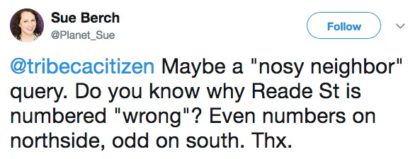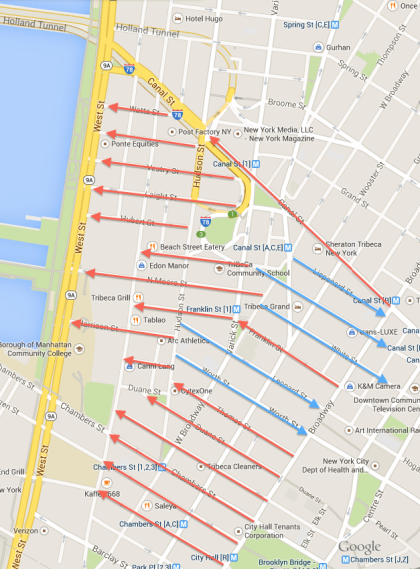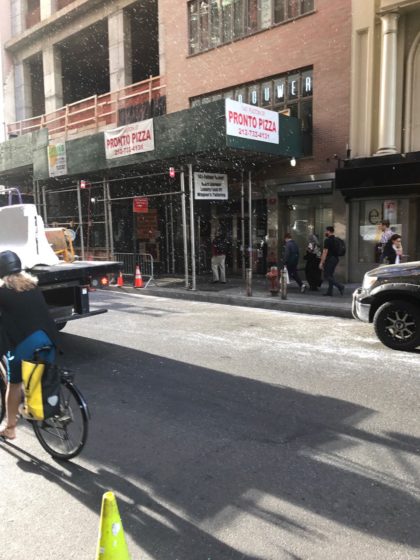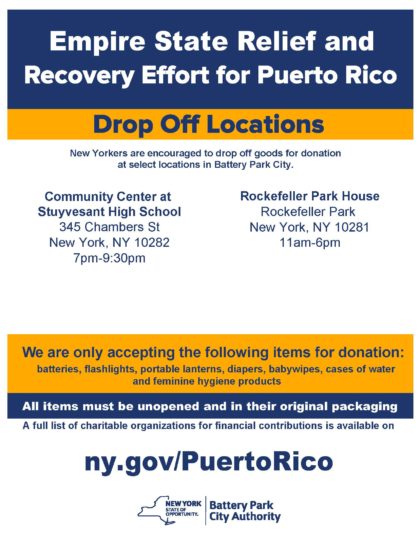Seen & Heard: Styrofoam Snowstorm
••• I’ve never found anyone who could answer a question like the one below. James, do you know who might know?
 ••• And if so, I have a question of my own. In this map, the blue arrows indicate streets where the street numbers start from the west; red arrows indicate street numbers increasing from the east.
••• And if so, I have a question of my own. In this map, the blue arrows indicate streets where the street numbers start from the west; red arrows indicate street numbers increasing from the east.
 ••• The Paris Review has organized a reading by Wojciech Nowicki of his new book, Salki at Aesop’s Tribeca store. “Your skin will crawl with pleasure from reading,” said Andrzej Stasiuk of Salki. Perhaps Aesop has something to help with that.
••• The Paris Review has organized a reading by Wojciech Nowicki of his new book, Salki at Aesop’s Tribeca store. “Your skin will crawl with pleasure from reading,” said Andrzej Stasiuk of Salki. Perhaps Aesop has something to help with that.
••• “There is white debris snowing down from 143 Fulton Street and accumulating heavily on Nassau and Fulton Streets,” emailed a reader yesterday. “The photo is from earlier today at the construction site. This pollution appears to be from styrofoam packing materials on the site.” (It’s actually the insulation material that gets pumped into the building.) “It’s not a small isolated mess—it spans for blocks and blocks spawning from the last three days. This debris is trickling all the way up to City Hall Park and apparently will continue for three more weeks. According to the site manager, they are trying to contain the problem—but the wind blows stuff away. I’ve never seen this in my 16 years of living through substantial changes and consistent construction downtown—never has tangible debris snowed down on our streets before. Neighboring buildings and schools are encouraging locals to call 311 to make a ‘building site’ and ‘environmental air quality’ complaint about the falling debris from 143 Fulton St. construction site since Monday, October 2. It is a simple and fast call, resulting in a confirmation number that can be emailed to Manhattan Community Board 1 at man01@cb.nyc.gov to highlight urgency of this issue.” That would exactly be my advice. You might also let @Marriott (the building will be a Moxy hotel) know via social media that it’s not being a good neighbor.
 ••• Again with the F/A-18s: “A flight of two Navy F/A-18 will fly over the Hudson River, north to the Tappan Zee Bridge, then fly south and near the Verrazano Bridge [today], 10/6, at approximately 5 p.m. The aircraft will fly between 2,500 – 3,000 feet.”
••• Again with the F/A-18s: “A flight of two Navy F/A-18 will fly over the Hudson River, north to the Tappan Zee Bridge, then fly south and near the Verrazano Bridge [today], 10/6, at approximately 5 p.m. The aircraft will fly between 2,500 – 3,000 feet.”
••• See below for a way to help Puerto Ricans. (Not to quibble, but maybe we should all just give money and they can buy the goods, ideally at a discount, somewhere nearer the island?)












Re: street addresses
I suggest contacting “Hector Rivera, Topographical Bureau Associate at the Manhattan Borough President’s Office.” His office manages and assigns house numbers. They should have the history here.
See
https://tribecacitizen.wpengine.com/2011/06/02/manhattan-monuments/
Thanks. I emailed Hector.
Ceiling collapsed on second floor of 390 Broadway, saw a bunch of fire trucks around 6-7pm on Friday night.
There are other streets downtown besides Reade Street with even numbers on the north side of the street, including as I recall Broome Street, Grand Street, Desbrosses Street, Vestry Street, Laight Street, Hubert Street, Walker Street, White Street, Franklin Street, Warren Street, and Wall Street (the last is numbered from Broadway and increasing going east).
Here is what I have gleaned from reading laws and secondary sources* about the history of street addresses online:
(1) Odd/even on north/south sides of the street and exceptions.
In 1793/94 the first law regulated uniform street numbers in New York is passed, separating odd and even numbers on opposite sides of the street, mandating the installation of street signs and the posting of permanent house numbers on buildings. That said, the regulation is not the clearest in trying to mandate odd numbers on the north side:
“Beginning at the next House in every Street terminating at either of the Rivers where such a Street intersects the main Street next to the River and all Houses below such intersecting Street to be number separately beginning with No. 1 looking upwards in all main Streets and downwards in all the Slips on the one side of the Street and No. 2 on the opposite side and so on to the end of the Street or Slip.”
Apparently house numbers were not even assigned on Reade Street until 1794.
One flaw I understand was that they numbered *existing buildings* consecutively instead of numbering *building lots* consecutively, so that both demolition of existing buildings and construction of new buildings between two existing buildings messed up the numbering scheme and then required frequent re-numberings.
(Wall Street was renumbered in 1794 to separate addresses into odds and evens. Before Wall Street was renumbered in 1845, however, it seems that the odds and evens switched sides of Wall Street part way along its length!)
In 1811 the familiar street grid was adopted for expansion north of the then-established city (with the street numbers starting from the west I understand).
In 1838 a law was enacted dividing Manhattan into East and West Sides, along 5th Avenue, north of 13th Street. House numbers started at No. 1 at 5th Avenue and grew larger going east and west as they do today.
In 1861 a law was enacted to solve the problem of construction and demolition of structures ruining the house numbering on a given street, from 9th Street north. From 5th to 6th Avenue, the numbers 1-99 would be assigned. From 6th to 7th Avenue, the numbers 100-199 would be assigned. From 7th Avenue, the numbering would start with 200, etc. etc. It is apparently from this time that streets from 9th St. north would be uniformly numbered odd on the north side and even on the south side.
(2) House numbers increasing sometimes to the east and sometimes to the west in Tribeca
According to “CHANGED HOUSE NUMBERS AND LOST STREET – NAMES IN NEW YORK OF THE EARLY NINETEENTH CENTURY AND LATER” By Henry B. Hoffmann
(published in THE NEW-YORK HISTORICAL SOCIETY QUARTERLY BULLETIN Vol. XXI JULY, 1937 No. 3),
“There are four basic types of house-number change which
have taken place in New York City. There is a simple shift of
house numbers, generally increasing the number of house numbers used in a given distance, and generally affecting different parts of the same street differently. […]
“The second type of renumbering is that necessitated by extension of a street at the end where the numbers formerly began (e.g. Cedar Street in 1829 and Canal Street in 1837 [extended east of Centre Street as I recall]) ; and the third type occurs when two or more independent streets, joining at the ends, are merged into one. […]
“A fourth type is the reverse of the third: one street or avenue becomes two or more. Finally, there is the appearance and disappearance of “Places” and “Squares” as addresses. These are little independent systems of house numbers, often alternative to the regular house numbers, but confined to one block, or at most a few blocks, of a given street or streets, and usually on one side of the street only. ”
Hoffmann gives the following interesting example of a street merger resulting in new house numbering on a Tribeca street.
“One more change downtown deserves mention here, the union of Franklin Street and Provost Street under the name of the former. The original Franklin Street had been laid out around 1800 as Sugarloaf Street, in the Calk Hook farm, and, like White Street, numbered from the west end, with the odd numbers on the south side. On receiving its present name, in 1811, it retained the original house numbers. Provost Street, one of the Trinity Church farm group of streets on the west side, met it at the foot of Varick Street, at Chapel (the modern West Broadway), and in 1833 it was annexed by Franklin Street. To make the numbers continuous, it was decided to reverse them on the original Franklin Street, numbering west from Orange (Baxter) Street. As a consequence, the Franklin-street Reformed Church (officially the Northwest Church), which had been Old No. 17, became New Number 107-111.”
Note that this may explain why modern Franklin Street east of West Broadway is an anomaly among the nearby streets to the north and south regarding in which direction the house numbers increase. Also it demonstrates that the original discontinuity at what is now West Broadway and Hudson Street–i.e., the east edge of the Trinity Church lands–may explain the observed differences in the direction of increasing house numbers to the east and west of West Broadway/Hudson Street.
*Secondary sources:
“‘A regular state of beautiful confusion’: governing by numbers and the contradictions of calculable space in New York City”
by REUBEN ROSE-REDWOOD in Urban History / Volume 39 / Issue 04 / November 2012, pp 624 – 638
“House Numbering” in The Encyclopedia of New York City: Second Edition edited by Kenneth T. Jackson, Lisa Keller, Nancy Flood
City on a Grid: How New York Became New York
By Gerard Koeppel
Remarkable Rise of Eliza Jumel: A Story of Marriage and Money in the Early Republic By Margaret Oppenheimer
“Alexander Hamilton Landmarks. The New Morgan Buildng in Wall Street” in the Nineteenth Annual Report, 1914, of the American Scenic and Historic Preservation Society; Documents of the Assembly of the State of New York, Volume 35, 1914
There are many residences and stores in this city that do not have a number on its door or windows. Is there a law about this, because it is not enforced? It is frustrating to look for a number and then find you are walking in the wrong direction, Buildings should be given 30 days to arrange for numbers to be applied and after 30 days fined, at least $200.00 per day. The lettering should be at least 10″ high and of a contrasting color to its background.